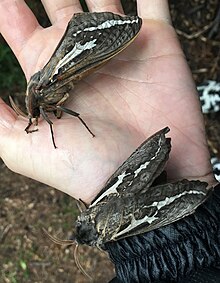Abantiades atripalpis
| Abantiades atripalpis | |
|---|---|

| |
| Scientific classification | |
| Domain: | Eukaryota |
| Kingdom: | Animalia |
| Phylum: | Arthropoda |
| Class: | Insecta |
| Order: | Lepidoptera |
| Family: | Hepialidae |
| Genus: | Abantiades |
| Species: | A. atripalpis
|
| Binomial name | |
| Abantiades atripalpis (Walker, 1856)
| |
| Synonyms | |
| |

Abantiades atripalpis, also known as bardee (bardy, bardi) grub, rain moth or waikerie, and previously known as Trictena atripalpis,[1] is a moth of the family Hepialidae. It is found in the whole southern half of Australia.
Habitat
[edit]The rain moth is found right across southern Australia in woodland areas alongside creeks and gullies, especially near eucalyptus trees.[2]
Larvae
[edit]The caterpillar is used by fishermen as bait.[2][3]
The larvae live in tunnels,[2] feeding on Casuarina pauper and Eucalyptus species, especially Eucalyptus camaldulensis.[3] They are herbivores.[2]
Moth
[edit]The wingspan is up to 120 millimetres (4.7 in) for males and 170 millimetres (6.7 in) for females.[3] They can be the same size as a small insectivorous bat, and owls often prey on them.[2] The body reaches a length of 120 mm.[4]
The adult females produce a great number (up to 40,000) of eggs, which are scattered while flying. Their flight months are in Autumn (April to June).[5]
References
[edit]- ^ Herbison-Evans, Don; Crossley, Stella. "Abantiades atripalpis". Australian Butterflies and their Caterpillars. Archived from the original on 22 April 2023. Retrieved 22 April 2023.
- ^ a b c d e NRM Education (Adelaide and Mount Lofty Ranges Natural Resources Management Board). Natural Resources, Adelaide and Mount Lofty Ranges: Creature features2013 – 2019. Government of South Australia.
Licensed under Creative Commons Attribution 3.0 Australia License
- ^ a b c Don Herbison-Evans & Stella Crossley (26 May 2008). "Trictena atripalpis". uts.edu.au. Archived from the original on 24 September 2009. Retrieved 11 February 2009.
- ^ "Sanctuary Lakes Resort - the Rain Moth". Archived from the original on 23 March 2021. Retrieved 1 May 2021.
- ^ Jennings, J.T., Austin, A.D., Davies, K., Harvey, M., Hirst, D. & Taylor, G. 2009, Terrestrial Invertebrates. In: Jennings, J.T. (Ed.) Natural History of the Riverland and Murraylands. (Royal Society of South Australia Inc.), pp. 306-333.
